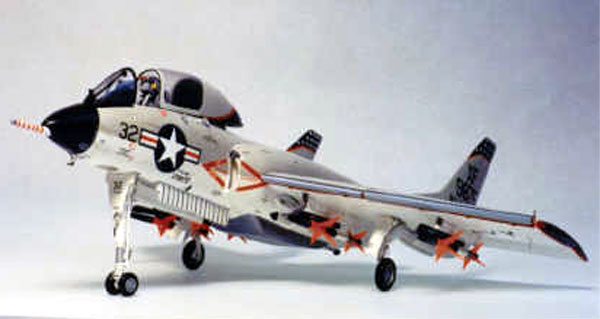|
Vought F7U-3M Cutlass
by Phil Brandt
 |
|
Vought F7U-3M Cutlass |
images by
Milton Bell

HyperScale is proudly supported by
Squadron.com
Possibly the most radical shipboard fighter design ever, the
Vought Cutlass led the way as Naval jet aviation came of age in the Fifties.
Although its service life was extremely short--the F7U was among an entire
generation of Navy jets doomed by Westinghouse's abject failure to produce
competent jet engines--Vought's design innovations pointed the way to the
future. Steve Ginter's excellent book, Naval Fighters Number Six, notes that the
Cutlass was the first American fighter designed from the outset to use
afterburner-equipped engines; the first swept-wing Navy aircraft; first tailess
jet to go into production in the U.S.; and the first Navy jet with steerable
nose wheels and an irreversible power control system. It was a tough plane to
land, especially coming aboard ship. The photo sequence in the Ginter book
showing a Cutlass ramp strike and subsequent fireball must not have been a great
naval aviation recruiting tool!
|
Hobbycraft's 1/48
Scale F7U-3M Cutlass |
This is Hobbycraft 1/48 scale F7U-3M Cutlass.

Hobbycraft has released two different quarter-inch kits of the Cutlass, both of
which appear to have been pantographed from the excellent Fujimi 1/72 kits: a
plain vanilla, all-plastic version, and a decidedly better-detailed "Elite" kit,
featuring cast metal landing gear/wheels and other smaller parts as well as a
fret of photoetch.
Bondo started this "Elite" kit over five years ago, ostensibly
as an Out Of the Box effort. However, as he assimilated the information in the
Ginter book, he became more and more dissatisfied with the kit's canopy profile
which appeared too shallow; the windscreen was also incorrect. In addition, the
canopy was too narrow and didn't bulge outward as in the real article. I carved
a new, wider and more "humped" master, strechforming a new one using Squadron's
"Thermaform" clear sheet.
The other profile that needed correcting was the bottom of the radome, and this
was done with A&B epoxy putty. The scratchbuilt air refueling probe helps mask
the fact that the profile is still not exactly correct!

I elected to open the large canopy because the complex ejection seat adds to the
"busy-ness" factor. The area behind the ejection seat was scratchbuilt with
various Evergreen stock. Same for much of the cockpit and seat, even though
Hobbycraft furnishes some PE for this area (seat, side panels and ill-fitting
instrument panel). After a trip to the Pensacola museum and a look at a
beautifully restored Cutlass, it became obvious that the afterburner cans were
significantly undersized, so I Dremeled out the openings and lined them with
concentric lengths of brass tubing. Although most later Cutlasses had the lower
intake lip enlarged with a prominent 'scab patch' for more airflow, I passed on
this mod because I was, frankly, tired of accurizing the Hobbycraft kit.
I've always admired the gull gray-and-white Navy paint schemes,
and the fact that Hobbycraft made the wing slats (and 'flaperons'!) positionable
gives the opportunity to use Guards Red to really set off the surfaces
underneath.
I chose the colorful markings of VX-4, the Navy's premier test squadron, because
that would allow use of bright orange first generation AIM-7s. The famous
star-studded tips of the vertical fins were only included on the decal sheet
that accompanied the "plain vanilla" Cutlass kit, but since I had one of each
kit........

The vertical fin tip decals were of relatively poor quality, and
often ripped even after prolonged soaking. In addition, the red edge trim was
overprinted on the blue field, so I cut off all red trim and created new Guards
Red strips on decal sheet stock. Dark Sea Blue gloss was used on the wingtips
and as fin tip touchup, along with the homemade red strips mentioned above.
Wingwalks, letters, numbers and stencils came from various Superscale Navy
sheets.
A dirty brown wash, appropriately streaked, gives just a hint of
shipboard use.
HC's Cutlass is a "Bondo-type" project if there ever was one.
Now that it's finished, watch for an injected release by Tamiyagawa!
Model and Article
Copyright © 2002 by Phil Brandt
Images Copyright © 2002 by Milton Bell
Page Created 09 April, 2002
Last updated 04 June, 2007
Back to HyperScale
Main Page
Back to Features Page |
Home
| What's New |
Features |
Gallery |
Reviews |
Reference |
Forum |
Search